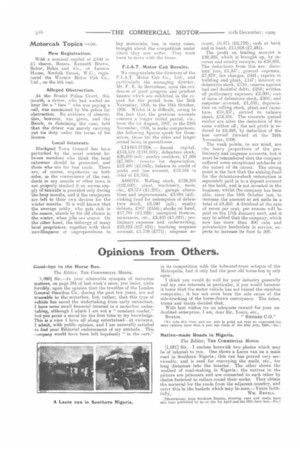Opinions from Others.
Page 18

If you've noticed an error in this article please click here to report it so we can fix it.
Good-bye to the Horse Bus.
The Editor, THE COMMIIRCIAL MOTOR.
-_1,080] Sir,—In your adudrable synopsis of motorbus matters, on page 284 of last week's issue, you insist, quite forcibly, upon the opinion that the troubles of the London General Omnibus Co., during the past few years, are not traceable to the motorbus, but, rather, that this type of vehicle has saved the undertaking from early extinction. I have some small financial interest in a motorbus undertaking, although I admit I am not a " constant reader," but you point a moral for the first time to my knowledge. This in a view I have all along entertained—at variance,
admit, with public opinion, and I am naturally satisfied to find your Editorial endorsement of my attitude. This company would have been left hopelessly " in the cart," in its competition with the tube-and-tram octopus of the Metropolis, had it only had the poor old horse-bus to rely upon.
I think you would do well for your industry generally and my own interests in particular, if you would hammer it home that the motor vehicle has not ruined the omnibus companies; it ham not even been the sole cause of the side-tracking of the horse-drawn conveyance. The tubes, trams and trains decided that.
With best wishes for an adequate reward for your undoubted enterprise, I am, dear Sir, Yours, etc., Buxton. "RETIRED C.O."
(We note this view, and are able to point out that we expressed the same opinion more than a year ago (issue of the 10th July, 12081.—Eu-I Native-made Roads in Nigeria.
The Editor, THE COMMERCIAL MOTOR.
[1,081] enclose herewith two photos which may
he of interest to you. One shows a Laere van on a main road in Southern Nigeria; this van has proved very serviceable, and is used for conveying the mails, etc., for long distances into the interior. The other shows the method of road-making in Nigeria; the natives in the picture are prisoners and are connected to each other by chains fastened to collars round their necks. They obtain the material for the roads from the adjacent country, and carry this in the baskets which may be seen.—Yours faith
fully, Wm. REveee.
• [Illustrations, from Southern Nigeria, showing vans and roads, have aLso been published by at on the lit April and the 17th June last.—En.)
























